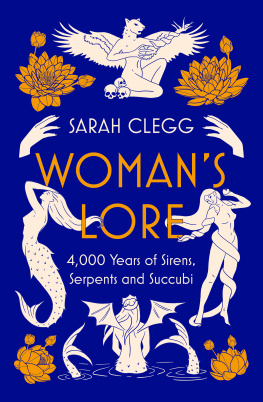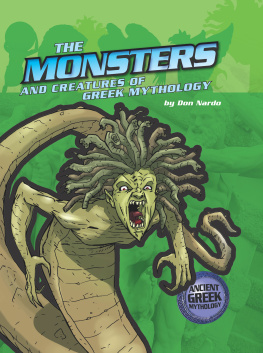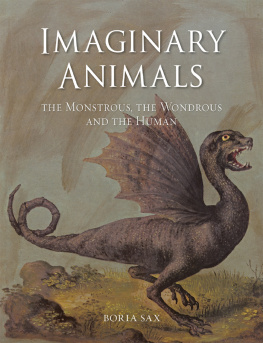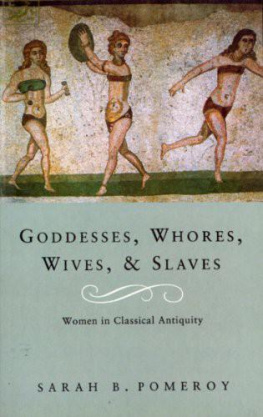WOMANS LORE
SARAH CLEGG
WOMAN'S
LORE
4,000 years of Sirens,
Serpents and Succubi
www.headofzeus.com
First published in the UK in 2023 by Head of Zeus Ltd,
part of Bloomsbury Publishing Plc
Copyright Sarah Clegg, 2023
The moral right of Sarah Clegg to be identified as the author of this work has been asserted in accordance with the Copyright, Designs and Patents Act of 1988.
All rights reserved. No part of this publication may be reproduced, stored in a retrieval system, or transmitted in any form or by any means, electronic, mechanical, photocopying, recording, or otherwise, without the prior permission of both the copyright owner and the above publisher of this book.
A catalogue record for this book is available from the British Library.
ISBN (HB): 9781803280271
ISBN (E): 9781803280257
Head of Zeus Ltd
First Floor East
58 Hardwick Street
London EC 1 R 4 RG
WWW . HEADOFZEUS . COM
For my brother
because once, a long time ago,
he did the same for me.
Contents
To hear her whisper womans lore so well,
and every note she spake enticd him on
Keats, Lamia , 325326
In all cases, the monsters discussed in this book have been given English plurals (Lamias as opposed to Lamiae, for example). In spanning numerous time-periods, languages and civilizations, the pluralizations of these names naturally vary wildly. Moreover, since these creatures are often under-attested in written sources, we dont always know their pluralizations for a given time period. The plural of the creature Gello for example, was Gelloudes in Byzantine sources, but should we back-apply this to Hellenistic Greece, where we dont have a surviving plural form of the word? For the sake of simplicity and clarity, English plurals are used instead.
Capitalization will also always be used for the demons under discussion. This is because they often shift from being a proper name of a single person, to a species of monsters, and back again. Lamia, for example, is both a much-wronged queen and a race of snake-tailed, seductive women. Often its unclear which is meant in an individual source. To avoid confusion, capitalization will be maintained throughout.
The key dates concerning our demons are in the left-hand column of the timeline below. To try to contextualize the 4,000 years of this tradition, the right-hand column contains important dates from history, such as the death of Tutankhamun and the beginning of the Crusades.
c .34003300 BC Earliest form of writing appears in Mesopotamia. |
c .20001500 BC First Lamashtu incantations and amulets. | c .1790 BC Hammurapi becomes king. |
c. 15001000 BC Writing of the first composite Lamashtu incantation in Ugarit, the likely Lamashtu text from Hattusa, and the Lamashtu text from Emar. | 1323 BC Death of Tutankhamun. |
c .700600 BC First Pazuzu incantations and amulets. | BC Death of Ashurbanipal. |
c .700600 BC Egyptian Pazuzu statuette inscribed with the name Ssm son of Pdr. c .570 BC Death of Sappho. c .500400 BC Greek vase showing Lamia with a phallus produced. | BC Fall of the Neo-Assyrian Empire. BC Sack of Jerusalem by Nebuchadnezzar II and the beginning of the Babylonian captivity. BC Creation of the Roman Republic. |
c .480 BC Vase showing the sirens as bird-bodied women surrounding Odysseus ship produced. c .450 BC Crates writes his play describing Lamia with a staff. | 499449 BC GraecoPersian Wars. |
BC First performance of Aristophanes play The Frogs , which mentions Lamias testicles. | BC Death of Plato. BC Death of Alexander the Great. |
BC The concubine Lamia is captured at the Battle of Salamis by Demetrius. c .300200 BC Likely period in which the poet Erinna was writing. |
BC Death of Duris of Samos, who wrote about Lamia. |
c .60 BC Diodorus Siculus writes Library of History , including his rationalizing account of Lamia. | BC Julius Caesar assassinated. |
BC Horace writes his Ars Poetica , mentioning Lamia devouring children. AD c .115 Death of Dio Chrysostom, who wrote about Lamia seducing and eating sailors. | AD 75 Writing of the last known cuneiform text. |
AD c .120 Date that Zenobius, the proverb compiler who preserved the fragment of Sappho relating to Gellos love of children, was teaching in Rome. AD 172200 Period in which Apuleius wrote the The Golden Ass . | AD 122 Construction of Hadrians Wall begins. |
AD c. 200 Composition of Philostratuss The Life of Apollonius of Tyana . | AD 224 Sassanian conquest of Mesopotamia. |
AD 200500 Compilation of the Babylonian Talmud. AD c .300 Manufacture of the silver scroll inscribed with the charm story of the encounter between Artemis and the headache monster Antaura. | AD 324 Constantine moves the capital of the Roman Empire to Constantinople. |
AD 300400 Compilation of the Cyranides . AD 300400 Earliest Mediterranean amulets produced that show Sisinis or Solomon impaling a woman with long, loose hair. AD 397 Death of Saint Ambrose. |
AD 400500 Greek Palestinian amulets, which depict Sisinnios impaling a woman, often shown with a snake tail and described as Abyzou produced. AD 400800 First attestation of the Sisinnios story in Mesopotamia and Palestine. AD 420 Death of Jerome, translator of the Vulgate Bible. | AD 476 Fall of Rome. |
AD 500600 The majority of the amulets depicting Sisinnios or Solomon impaling Abyzou produced. AD 500800 Incantation bowls made and used. | AD 570 Birth of the Prophet Muhammed. |
AD 600 Death of Leander of Seville, who wrote that all women who were not nuns were sirens. | AD 636 Muslim conquest of Mesopotamia. AD 661 Foundation of the Umayyad Caliphate. |
AD c .700 Composition of the Liber Monstrorum , one of the first texts to use the term mermaid. |
AD c .7001000 Composition of the Alphabet of Ben Sira. AD 749 Death of John of Damascus, the Christian monk, priest and author, who wrote dismissively about the Gello. | AD 730787 First iconoclastic period in the Byzantine Empire. |
AD c .806 Death of Saint Tarasios, who supposedly held a trial for Gello-possessed elderly women. 1072 Death of Peter Damian, who wrote angrily about sirens and Lamias. | AD 800 Coronation of Charlemagne as Emperor of the Romans. |
1074 The Pope absolves people of obedience to bishops who allowed married priests. 1165 Creation of the mosaic floor in Otranto Cathedral. | 1095 Beginning of the First Crusade. 1153 Death of the Byzantine historian Anna Komnene. |
c .1220 Death of Gervase of Tilbury, author of Otia Imperialia. c .1280 Likely date of the composition of The Treatise of the Left Emanation . | 1204 Sack of Constantinople by crusader armies. 1215 Signing of the Magna Carta . 1273 End of the last major crusade in the Holy Land. 1299 Founding of the Ottoman Empire by Osman I. |
1305 Death of Moses de Len, discoverer (or author) of the Zohar . |












